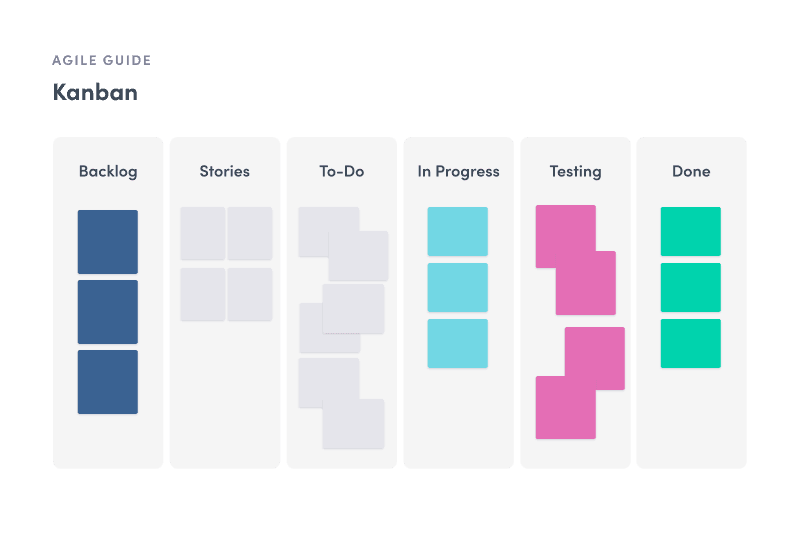Updated: January 3, 2025- 13 min read
User stories connect the people who make products to the people who use them. They remind those of us on this side of things — Product Managers, designers, developers, etc. — whom we’re working for: the customer. Behind every line of code and every prototype is a person who has a task that they want to complete and a reason for doing so.
User stories are simple descriptions of that user, task, and reason. Usually just a sentence long and often found written on a sticky note (whether physical or virtual) on a kanban or scrum board, user stories’ superpower is their simplicity.
User story templates are crucial in Agile product development. They provide a standardized way to capture requirements and ensure everyone on the team understands the task at hand. Using the right user story structure can make all the difference in delivering value efficiently. In this article, we’ll explore four types of user story templates: Simple, Epic, Thematic, and SAFe, each designed for different purposes in product development.
For each type of user story, we at Product School have an easy-to-use customizable template for you and your team. Download all four for free to get to work today.
User Story Templates
Our User Story Templates keep product development centered on real user needs and objectives. Available in 4 formats, they're easy to use whether you're planning a small feature or a full program!
Free download
What Is a User Story?
A user story is a short, simple description of a feature or task told from the perspective of the end user. They’re small chunks of work that need to be done, such as a button being added to a landing page or a minor feature being added to an onboarding flow.
In Agile development, user stories are a fundamental way of capturing requirements and focusing on user needs rather than technical details. The goal is to create a shared understanding between the development team and stakeholders about what the product should do.
As the platform product manager, you have to adjudicate between all the competing priorities. So you have to absolutely understand what the end customer value is. Because ultimately, you're going to have to say no to somebody, and when you do, you need to be able to say, "Here's the value that we're driving for our customer. Here's the value we're going to be driving for our business." That way, even if the other person is disappointed, they can't argue.
— Justin Kim, VP of Product, Vimeo
The standard user story format is:
As a [type of user], I want to [task] so that I can [objective].
This format helps teams keep the user at the center of the conversation, ensuring that development efforts are always aligned with delivering value to the end user.
Acceptance Criteria
Acceptance criteria are specific conditions that must be met for a user story to be considered complete. They provide clear, testable requirements that help developers and stakeholders agree on the scope and definition of “done” for a particular story.
An example of a standard acceptance criteria format is:
Given [initial context], when [action performed], then [expected outcome], and [additional outcomes, if any].
By defining acceptance criteria, teams can ensure that user stories are customer-centric and measurable, leading to more predictable outcomes and fewer misunderstandings during the development process.
User Stories in Agile Product Development Frameworks
User stories play a crucial role in various Agile product development frameworks. In many cases, they are the smallest project unit within a larger system of continuous or iterative development.
Kanban
In Kanban, user stories help teams visualize the flow of work. Stories are added to the Kanban board and move through various stages of development—such as "To Do," "In Progress," and "Done." The focus in Kanban is on continuous delivery and reducing bottlenecks, with user stories providing a clear picture of work that needs to be completed.

Scrum
In Scrum, user stories are the primary units of work, defining features or requirements from the user's perspective. Stories are added to the product backlog and prioritized during sprint planning sessions. Scrum teams work on user stories in sprints with the goal of completing a potentially shippable product increment.
SAFe (Scaled Agile Framework)
In SAFe, user stories are used to break down features into manageable tasks that can be completed by individual teams within a Program Increment (PI). User stories align with the larger goals set out by Epics and are essential for planning and execution at scale. SAFe emphasizes the INVEST criteria—making sure user stories are Independent, Negotiable, Valuable, Estimable, Small, and Testable—to ensure effective coordination across large teams and Agile Release Trains.
Simple User Story Templates
A simple user story template is a concise, straightforward description of a feature or functionality told from the perspective of an end user. It follows the classic Agile user story format:
As a [type of user], I want to [task] so that I can [objective].
Simple user stories are easy to understand and focus on a single feature or task, making them ideal for teams looking to implement small, incremental changes.

When to Use the Simple User Story Template
Simple user stories are best used for:
Incremental updates that improve an existing product.
Straightforward features that can be implemented quickly.
Using a simple user story format helps teams focus on delivering small, actionable features without overcomplicating the process.
Simple user story and acceptance criteria example
Sample user story:
As a new user, I want to create an account so that I can access the platform and start using its features.
Acceptance criteria example:
Given the user has initiated the sign-up process, when they fill in the required information and click 'Submit,' then the user should receive a confirmation email and be able to access the platform.
Tips for Using a Simple User Story Format
Keep it concise: Ensure the user story is focused on a single user need or feature.
Testable and clear: Make sure the acceptance criteria are specific and measurable so that the team knows when the story is complete.
Assign it a priority: Prioritize the story relative to others in development.
Estimate the effort: Use story points or job size to indicate how long the story will take to complete.
Collaborate with stakeholders: Work with product owners and stakeholders to ensure the story captures the intended value for the end user.
Epic User Story Templates
An epic is a large-scale user story that encompasses multiple related features or functionalities. It represents a significant piece of work that can span several sprints or iterations. Think about classical epics like The Odyssey or the Ramayana. Within each epic, there are multiple story arcs that weave together to make the larger saga.
Similarly, the purpose of an epic user story template is to provide an overarching vision that can be broken down into smaller, more manageable user stories, allowing the team to incrementally work towards a larger goal.
Epics are crucial for aligning product roadmaps with business objectives, helping teams understand the bigger picture, and maintaining a strategic direction while delivering continuous value.

When to use an epic story template
Complex Initiatives: Epics are ideal for projects that are too large to be completed in a single sprint and require coordination across multiple teams or disciplines.
Organizing Features: When dealing with features that involve multiple workflows or user roles, an epic helps organize related tasks into a cohesive structure.
Example of an epic and related user stories
Epic: Develop a shared workspace where team members can manage projects, assign tasks, and communicate in real time.
Related User Stories:
As a team member, I want to create a shared project board so that everyone can view the progress of ongoing tasks.
As a project manager, I want to assign tasks to specific team members so that responsibilities are clear and tracked.
As a team member, I want to receive notifications for updates in shared projects so that I am always informed about changes.
Writing tips for the Agile epic story format
Break Down the Epic: Break down the epic into smaller, actionable user stories that can be completed within a single sprint.
Define Scope with Acceptance Criteria: Establish clear acceptance criteria to define the boundaries of each user story, ensuring everyone is aligned on what is needed to complete it.
Link to Objectives: Connect the epic to broader strategic goals or Product OKRs to maintain focus on value-driven development.
Ensure Consistency: Maintain a consistent user story structure across the epic's related stories to improve clarity and alignment.
Thematic User Story Templates for Strategic Goals
A thematic user story template groups related user stories under a broader theme to align product development with strategic objectives. Themes are the highest level of strategic focus in Agile methodology. They allow teams to address a particular user or business need holistically rather than focusing on individual features in isolation.

When to use a thematic user story format
Thematic templates are particularly effective for long-term initiatives that involve multiple areas of the product and require coordinated development efforts to achieve meaningful outcomes.
Cross-functional projects: When projects involve collaboration across multiple teams or departments, a thematic template helps ensure cohesion.
Long-term Objectives: Perfect for initiatives that require long-term planning and development, such as improving user engagement or enhancing a specific aspect of the user experience.
Thematic user stories example
Theme: "Enhancing customer support."
Stories:
As a night shift worker, I want to ask a chatbot simple questions to get answers outside of normal business hours.
As a new user, I want a self-service help center so that I can find answers to my questions without needing to contact support.
How to use the thematic user story template
Product School’s free thematic user story template includes the following elements to be customized by each team:
Theme: The overarching topic or strategic objective that groups related user stories together.
User Story: The specific feature or requirement written from the user's perspective and related to the theme above.
Priority: Indicates the level of urgency of the tasks associated with the user story, often determined by the product owner or stakeholders, in order to help the team focus on high-value tasks.
Estimate (# of story points): The effort required to complete the user story, typically estimated in story points to represent complexity and time.
Acceptance Criteria: Specific conditions that must be met for the user story to be considered complete.
Release: The version or milestone associated with each user story in order to track when new features will be delivered.
Tips for thematic user story templates
Maintain Consistency: Ensure that all related user stories align with the overarching theme.
Estimate effort with story points: Story points are units used in Agile product management to estimate the effort required to complete a user story. Unlike time-based estimates, story points help teams estimate effort while remaining flexible and open to iteration. There are many ways to decide how many points each story should have, with teams using everything from the Fibonacci sequence to a simple ranking system to arrive at an educated guess.
Use Clear Acceptance Criteria: Provide acceptance criteria for each user story to clarify what success looks like and ensure that development meets user needs.
User Story Templates
Our User Story Templates keep product development centered on real user needs and objectives. Available in 4 formats, they're easy to use whether you're planning a small feature or a full program!
Free download
Scale with SAFe User Story Templates
In the Scaled Agile Framework (SAFe), user stories streamline work at the team level while maintaining alignment with larger business objectives. SAFe user stories are designed to be small, actionable, and connected to features or epics that contribute to overall product development goals.

When to use the SAFe user story template
Team-Level Work: SAFe user stories are ideal for managing tasks that are actionable by individual teams within a larger program or Agile Release Train.
Aligning with Features and Epics: When user stories need to be connected to larger initiatives (such as features and epics) while maintaining independence for team-level work.
Scaled Planning: Use the SAFe template to align team-level user stories with the broader objectives set by features and epics in the Program Increment (PI) planning process.
How to use the SAFe user story template with examples
Sample user story: "As a finance manager, I want to automatically generate monthly financial reports so that I can save time and reduce manual errors."
Description: Brief summary of the story or feature. For example, “This story focuses on automating the financial reporting process to save time and improve accuracy, reducing manual work for finance managers.”
Hypothesis: Proposed measurable benefit of the feature, i.e. “Automating monthly financial reports will improve efficiency, reduce the time spent on manual tasks, and minimize errors.”
Nonfunctional Requirements: Performance, security, or compliance criteria, as in “Must comply with all relevant data security, GDPR, CCPA, and other market-specific privacy regulations.”
Acceptance criteria example:
Given that it’s the end of the month, when the system processes financial data, a PDF summarizing the monthly financial report should be generated automatically and arrive in the finance manager’s inbox.
User-Business Value: The estimated value as it relates to the business and the end-user. Let’s say that in this example, the value might be estimated at 5 because the feature will not directly impact revenue, but it will close an existing feature gap with a competitor.
Time Criticality: Time Criticality is another relative estimate that refers to how urgent it is to complete a feature by a certain date. For example, given the competitor just released a similar feature, time criticality might be an 8.
Risk Reductions/opportunity enablement: Insights on risk reduction, such as an opportunity that won’t last. For example, if users are switching to a competitor that offers the automated report proposed in the user story, the risk reduction score might be 13.
Cost Of Delay (CoD): CoD is based on analysis quantifying the potential negative impact of delaying the development of the feature. Cost of delay can the estimated lost revenue over time ($20,000 / week), or the relative measure of user-business value + time criticality + risk reduction. In this example, that would be 5+8+13 =26.
Job Size: The size of the job has to be estimated based on complexity and is usually relative to other user stories. For example, a job size of 5 is used for a medium-sized job, whereas 1 would be a very simple user story and 13 would be a complicated job.
Weighted Shortest Job First (WSJF): WSJF = CoD divided by Job Size. For example, 26÷5 would equal a WSJF score of 5.2. The score is only meaningful when compared to other scores that are calculated the same way, for example, according to the WSJF formula.
Notes: A space for other relevant information.
Tips for scaled agile user story templates
Keep Stories Small: Ensure each story is manageable and can be completed within a sprint. Use the INVEST criteria to refine user stories.
Align with Features: Clearly link user stories to the larger features or epics they support to ensure traceability and alignment with strategic goals.
Ensure Testability: Make sure acceptance criteria are specific enough to allow easy testing and validation of the story's completion.
Four User Story Template Formats, One Purpose
In this article, we've explored four different user story templates—Simple, Epic, Thematic, and SAFe—and how each one puts the user at the center of the product development process. The choice of template depends on your team's needs, the complexity of the work, and the strategic objectives of your product.
Experimenting with different user story templates and tailoring them to your context will ultimately help improve collaboration, productivity, and the success of your product.
Download Product School's user story templates to try out these approaches in your own projects!
User Story Templates
Our User Story Templates keep product development centered on real user needs and objectives. Available in 4 formats, they're easy to use whether you're planning a small feature or a full program!
Free download
Updated: January 3, 2025





